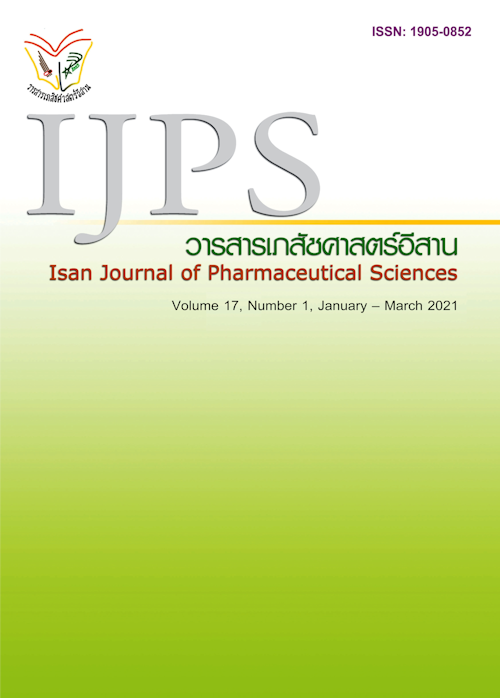Determination of Phenolic Compounds, Proteins and Antioxidant activity in Rice Water Fraction Extracted from Phayaleumkang Glutinous Rice
Main Article Content
Abstract
Phayaleumkang glutinous rice is upland rice that farmers usually plant for household consumption and it contains plenty of nutrient-rich. The objective of this study was to determine total phenolic content, antioxidant activity, and protein content of rice water fractions from Phayalumkang glutinous rice, and the accelerated stability study of rice powder (at 45 ± 2oC, 75 ± 2 % RH) during 1, 2, 3, and 4 months was investigated. Material and Methods: Paddy rice and brown rice were water extracted by three different extraction methods including rice water prepared by the boiling process: RWB, rice water prepared with the intact grain: RWM) and rice water prepared with the crushed grain: RWS. The extractions were analyzed the antioxidant activities by 1, 1-diphenyl-2-picrylhydrazyl (DPPH) and oxygen radical absorbance capacity (ORAC), total phenolic content by Folin-Ciocalteu reagent, and protein content by Bradford reagent. Results: The paddy rice and brown rice water fractions from RWS showed the highest of antioxidant activity, total phenolic content, and protein content. The accelerated stability study during 1, 2, 3, and 4 months were indicated that the antioxidant activity and protein content were significantly decreased (p<0.05). Conclusion: Rice water fractions of paddy rice and brown rice extracted from RMS showed the highest content of active compounds.
Article Details
In the case that some parts are used by others The author must Confirm that obtaining permission to use some of the original authors. And must attach evidence That the permission has been included
References
Bradford, M. M. (1976). A rapid and sensitive method for the quantitation of microgram quantities of protein utilizing the principle of protein-dye binding. Analytical Biochemistry, 72(1), 248-254.
Bopitiya, D. & Madhujith, T. (2014). Antioxidant potential of rice bran oil prepared from red and white rice. Tropical Agricultural Research, 26(1), 1-11.
Chaiyasut, C., Kesika, P., Sakdakampanat, P., Peerajan, S. & Sivamaruthi, B.S. (2018). Formulation and evaluation of stability of Thai purple rice bran-based cosmetic products. Asian Journal of Pharmaceutical and Clinical Research, 11(1), 99-104.
Fasahat, P., Abdullah, A., Muhammad, K., Musa, K. H. & Wickneswari, R. (2013). New red rice transgressive variants with high antioxidant capacity. International Food Research Journal, 20(3), 1497-1501.
Huang, D. J., Chen, H. J., Lin, C. D. & Lin, Y. H. (2005). Antioxidant and antiproliferative activities of water spinach (Ipomoea aquatica Forsk) constituents. Botanical Bulletin - Academia Sinica, 46, 99-106.
Le, Q. & Songsermpong, S. (2014). Head rice yield, pasting property and correlations of accelerated paddy rice aging properties by microwave heating conditions. International Food Research Journal, 21(2), 703-712.
Marto, J., Neves, A., Gonçalves, L. M., Pinto, P., Almeida, C. & Simoes, S. (2018) Rice Water: A traditional ingredient with anti-aging efficacy. Cosmetics, 5(2), 1-12.
Manosroi, A., Chutoprapat, R., Sato, Y., Miyamoto, K., Hsueh, K., Abe, M. & Manosroi, J. (2011). Antioxidant activities and skin hydration effects of rice bran bioactive compounds entrapped in niosomes. Journal of Nanoscience and Nanotechnology, 11(3), 2269-2277.
Moongngarm, A., Daomukda, N. & Khumpika, S. (2012). Chemical compositions, phytochemicals, and antioxidant capacity of rice bran, rice bran layer, and rice germ. APCBEE Procedia, 2, 73-79.
Nishimura, M., Yoshida, S. I., Haramoto, M., Mizuno, H., Fukuda, T., Kagami-Katsuyama, H., et al. (2016). Effects of white rice containing enriched gamma-aminobutyric acid on blood pressure. Journal of Traditional and Complementary Medicine, 6, 66-71.
Lim, S.T., Lee, J.H., Shin, D.H. & Lim, H. S. (1999). Comparison of protein extraction solutions for rice starch isolation and effect of residual protein content on starch pasting properties. Starch, 51(4), 120-125.
Pedro, A. C., Granato, D. & Rosso, N. D. (2016). Extraction of anthocyanins and polyphenols from black rice (Oryza sativa L.) by modeling and assessing their reversibility and stability. Food Chemistry, 191, 12-20.
Rattana Muangrat, Pongsathorn Tomtong, and Jaratsri Luangpan, (2016).Total phenolic compounds extraction from Kluai Hom Thong peels using subcritical solvent extraction technique. Srinakharinwirot University (Journal of Science and Technology), 8(15), 54-65.
Rice Research and Development Division (2016). Phayaleumkang Glutinous Rice. Khon Kaen: Khon Kaen Rice Research Center.
Singleton, V.L., Orthofer, R. & Lamuela-Raventos, R. M. (1999). Analysis of total phenols and other oxidation substrates and antioxidants by means of folin-ciocalteu reagent. Methods in Enzymology, 299, 152-178.
Srisawat, U., Panunto, W., Kaendee, N., Tanuchit, S., Itharat, A., Lerdvuthisopon, N., et al. (2010). Determination of phenolic compounds, flavonoids, and antioxidant activities in water extracts of Thai red and white rice cultivars. Journal of Medical Association of Thailand, 93, suppl 7, S83-S91.
Tananuwong, K. & Tewaruth, W. (2010). Extraction and application of antioxidants from black glutinous rice. LWT - Food Science and Technology, 43(3), 476-481.
Wang, M., Hettiarachchy, N.S., Qi, M., Burks, W. & Siebenmorgen, T. (1999). Preparation and functional properties of rice bran protein isolate. Journal of Agricultural and Food Chemistry, 47, 411-416.
Wei, C., Kwon, O. Y., Liu, X. W., Kim, H., Yoon, W. K., Kim, H. K., et al. (2007). Protein profile of major Korean rice cultivars. Preventive Nutrition and Food Science, 12(2), 103-110.


